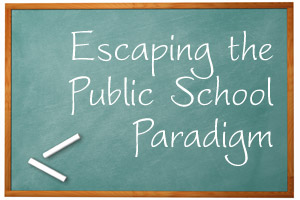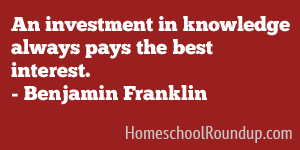Escaping the Public School Paradigm
 There is no one right way to homeschool, and each family will work out the system that works best for them. One important thing to remember however, is that the public school system really doesn’t have to be the “model” for how we “do” school. In fact, if we thought the public school system was so great, we’d be sending our kids there. While I don’t advocate throwing the baby out with the bathwater, I think there are many public school paradigms that we can allow ourselves to become trapped by unnecessarily.
There is no one right way to homeschool, and each family will work out the system that works best for them. One important thing to remember however, is that the public school system really doesn’t have to be the “model” for how we “do” school. In fact, if we thought the public school system was so great, we’d be sending our kids there. While I don’t advocate throwing the baby out with the bathwater, I think there are many public school paradigms that we can allow ourselves to become trapped by unnecessarily.
Grade Structure
As we all know, the public school system begins formal instruction at about 5 years old, and structures each year into a grade level with certain expectations for achievements in each level. It can be more productive and less stressful to think of school as more of a “Continuum of Learning” in which we continue the natural teaching we do as parents that we’ve been doing all along without the structures that are necessary for operating a public school.
With this idea of a continuum, comes a freedom from grade levels and the appropriate age at which to begin school. This idea encourages learning as a life practice, one which begins when we are infants and never ends, instead of the idea of finishing a certain amount of “grade level” work within one school year. It’s not necessarily about tossing those things completely out the window, as they can be useful as a sort of loose gauge of how things are going with each child, but that is all. They need not constrain us.
For example, when should you begin a formal curriculum with your child? The Autumn after your child turns 5? You can, but that’s a artificial constraint. Begin when your child seems ready. If your child is ready to learn to read later than according to public school standards, don’t stress too much about it, as even kids who learn to read at later than the “average” can be book lovers no matter when they become proficient readers. What if your child moves quickly through their math book and finishes it in March? Start the next one!
How Much Should Be Accomplished in a Year
Depending on the child, there may be times in their lives when they learn more quickly and times when they learn more slowly. Some years are full of things that make time for schoolwork more difficult to find, like new babies, sickness, travel, etc. Some years, a child may zip through things because of where they are developmentally. It may be helpful to think more “big picture” Set goals, yes, but don’t panic if they’re not met every time.
School Schedule
Since in our culture, public school generally runs from early fall to late spring, with a huge break in the summer, when we begin to homeschool, we may fall into that schedule without really even thinking about it. However, is this really the best for your family? For some it may be, and for some it may not. Sometimes the climate you live in may help guide when you take breaks from school. In the south, for example, it’s just not possible to get outside to play much during July and August so that’s a great time for a heavier schoolwork load, while the spring and fall might be perfect times to take extended breaks. Taking a huge break at any time of the year is clearly bad for retention, and many families choose to homeschool year round.
School Setting
Many a parent has set about homeschooling with the idea of creating the perfect learning environment, modeling their schoolroom like those they grew up with. There are desks, chalkboards, the alphabet and maps on the walls, etc. and pretty soon there are children and parents who feel uncomfortable and unhappy. While this schoolroom setting may work well for some, for many it works much better to “loosen up” a bit. Obviously, to have a good position for writing, use a desk or table for the schoolwork that requires it, but for other subjects, giving kids the freedom to find their own comfortable spot is helpful.
What do you think? Are there other ways we constrain ourselves by hanging onto the public school paradigm?







Well, to some extent we cannot escape the public school paradigm because the state has it follow us into our very homes. As for example, next year onwards my oldest has to the the standardized test. She will be in 6th grade. >gasp< did I just say 6th grade? Time to hit the panic button. My youngest will be 6 in August and will now have to be registered with the state to be a homeschooler too. With my daughter we have a much clearer idea where she is in terms of her education as she was homeschooled for 4th and 5th grade. Much of her material is advanced though. With my son its harder. I started teaching him when he was three via play. He isn't quite six now but reads, writes and does second grade math. Because he is exposed to much nature study and science in our home he knows considerably more than other kids his age, so how do I pigeonhole him?
I love the flexibility of changing course in the middle of the day when they can't or don't want to focus on their work. We'll pop in an educational nature DVD. After an hour of watching they have a new assignement. For Missy it's writing about the organism that interested or impressed her the most. For Bear it's drawing a picture along with writing the name of the organism and dictating to be what he learned. They've never complained about that 🙂